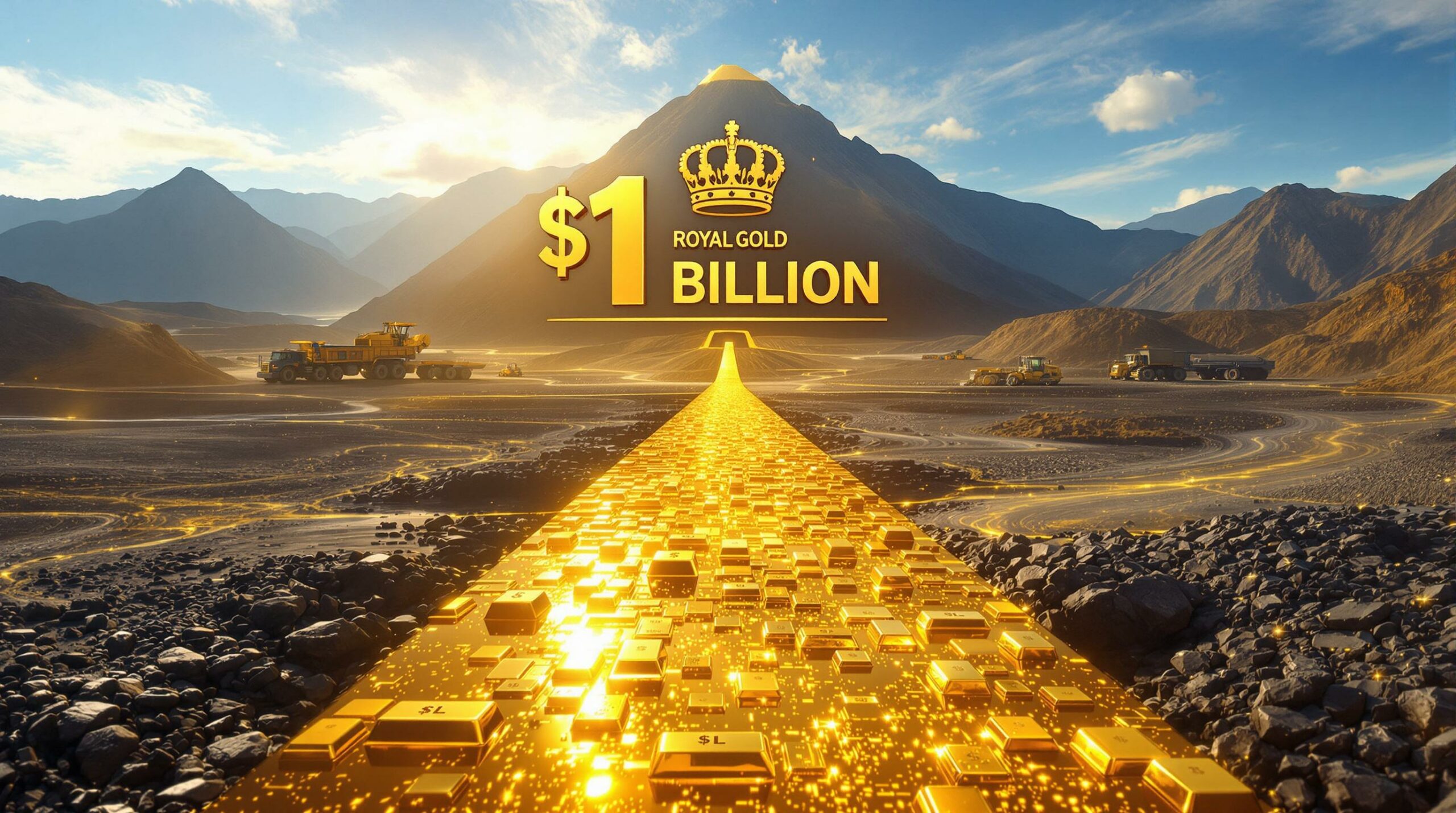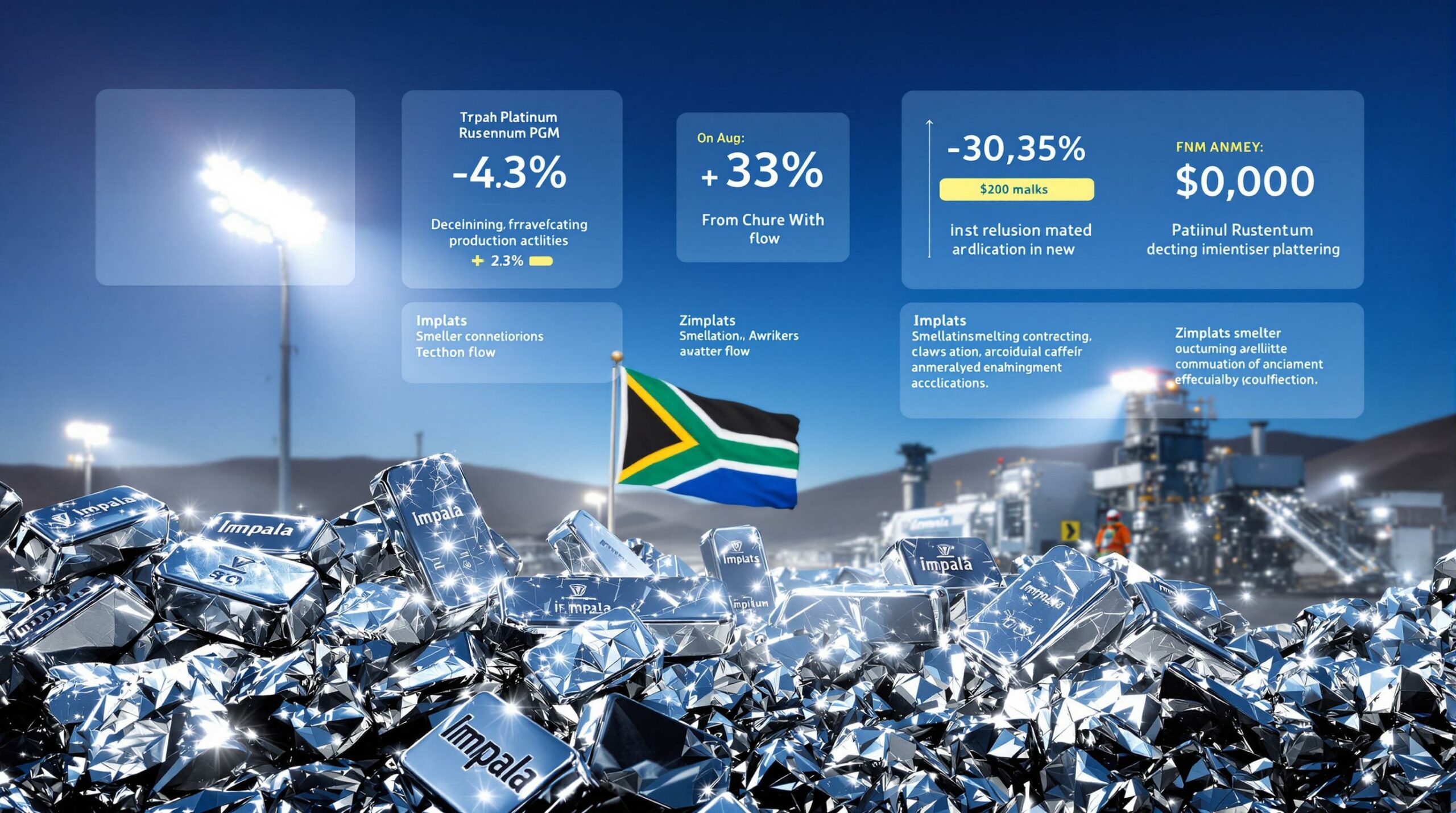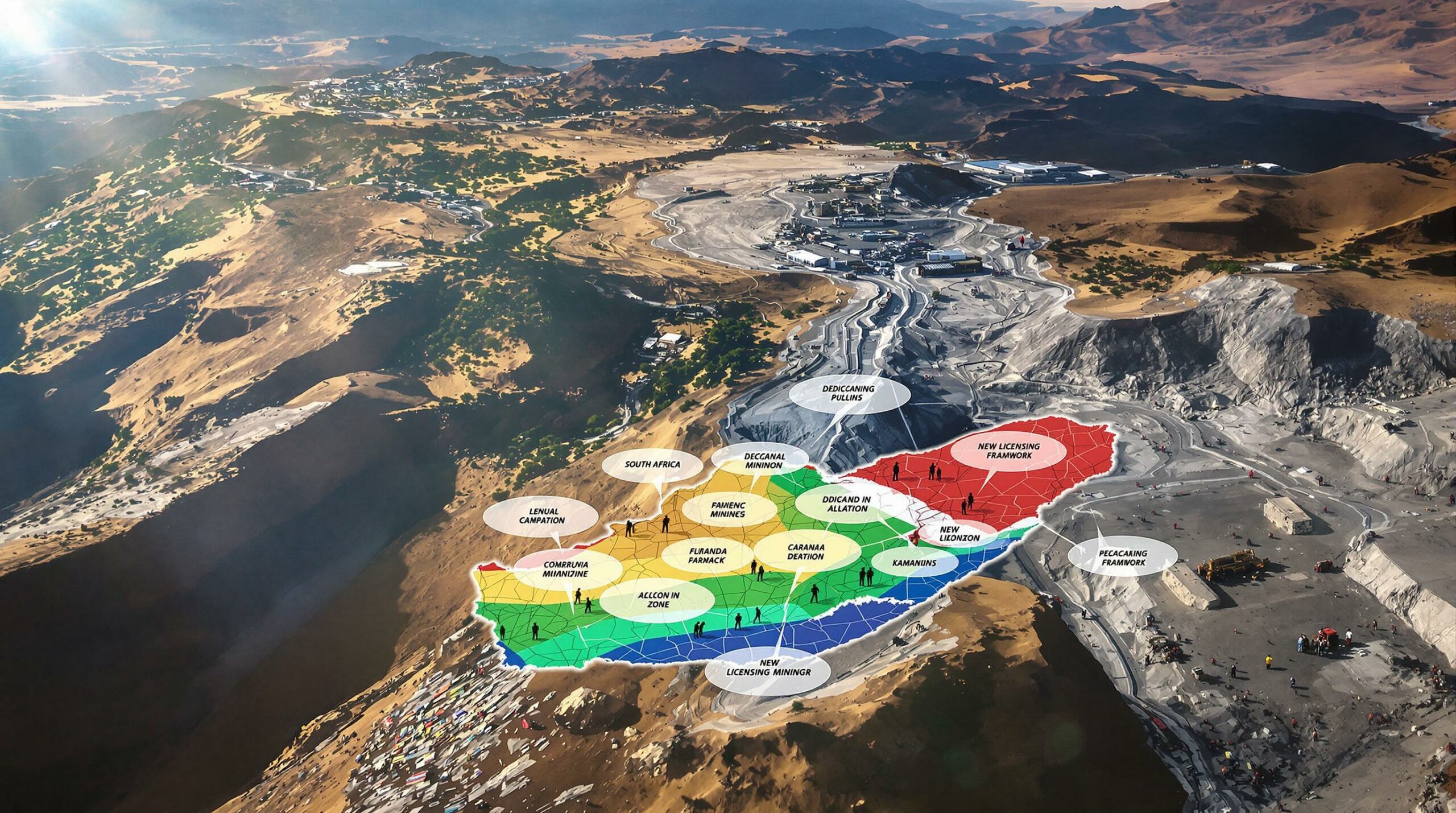South Africa's Mining Investment Standoff: Government-Industry Tensions Over US Partnerships
The South African mining sector faces increasing internal friction as government officials and industry leaders clash over critical minerals strategy and international partnerships. A recent public dispute between Mines Minister Gwede Mantashe and Sibanye Stillwater CEO Neal Froneman highlights the fundamental differences in approach to mineral resource development and foreign investment—with potentially far-reaching consequences for South Africa's mining investment climate.
Why Is South Africa's Mining Minister Clashing With Industry Leaders?
The tensions between South Africa's government and mining executives erupted publicly following Minister Mantashe's rejection of a business proposal aimed at offering the United States preferential access to Africa's critical minerals. This development represents the latest chapter in ongoing government-industry frictions over South Africa beneficiation approaches.
The Rejected US Minerals Access Proposal
In a move that caught industry observers by surprise, Mines Minister Gwede Mantashe firmly rejected a proposal that would have positioned South Africa as a strategic gateway for US access to critical minerals across the African continent. The proposal was developed by Sibanye Stillwater CEO Neal Froneman and board member Rick Menell ahead of President Cyril Ramaphosa's May 2025 meeting with former US President Donald Trump.
"The proposal was designed to leverage South Africa's mining expertise and continental relationships to create a mutually beneficial partnership with the United States," explained a mining industry analyst familiar with the situation. "But it was developed without government involvement, which proved to be its undoing."
The initiative, which industry proponents claimed would strengthen South Africa's position in global mineral markets while improving diplomatic ties with the US, was dismissed by Mantashe before it could reach President Ramaphosa's consideration.
Key Points of Ministerial Objection
Minister Mantashe's rejection centered primarily on procedural concerns rather than the proposal's substantive merits. He specifically cited the lack of consultation with the Department of Mineral Resources and the Minerals Council South Africa—the country's main mining industry body—during the proposal's development.
"There can be nothing about mining without" ministry and industry input, Mantashe stated firmly when explaining his decision to Bloomberg News. This statement underscores the government's insistence on centralized decision-making and formal consultation processes for mineral resource initiatives.
Particularly problematic for Mantashe was language in the proposal suggesting "make minerals great again"—phrasing he dismissed as inappropriate terminology for South African mining policy. This wording, echoing former US President Trump's campaign slogan, struck government officials as politically charged and misaligned with South Africa's resource sovereignty principles.
The minister's refusal to advocate the proposal to President Ramaphosa despite business pressure highlights the growing divide between government priorities and industry ambitions in South Africa's mining sector.
How Does This Dispute Reflect South Africa's Mining Industry Tensions?
The clash between Mantashe and Froneman represents more than a disagreement over a single proposal—it illuminates systematic tensions that have characterized South Africa's mining industry in recent years. These frictions occur against a backdrop of declining mining investment and increasing global competition for critical mineral resources.
Ongoing Government-Industry Relationship Challenges
"This dispute is symptomatic of the communication breakdown between government and industry that has persisted for years," notes a Johannesburg-based mining consultant. "When the country's largest platinum producer can't effectively engage with the mining ministry, it signals serious structural problems in the relationship."
Industry representatives frequently express frustration regarding regulatory delays and policy uncertainty that hamper investment and operational planning. Mining executives cite permitting processes that can stretch for years, frequent policy revisions, and inconsistent implementation of regulations as major obstacles to business growth and investment.
These challenges have contributed to South Africa's declining share of global mining exploration expenditure, which has fallen from approximately 5% in 2003 to less than 1% today, according to industry data. Meanwhile, other African nations like Ghana, Botswana, and Namibia have increased their share of continental mining investment through more investor-friendly policies.
Competing Strategic Approaches
At the heart of the Mantashe-Froneman clash lies a fundamental disagreement about how South Africa should develop and leverage its mineral resources. The government, under Mantashe's leadership, prioritizes domestic control and sovereignty over mineral assets, viewing resources primarily through the lens of national development and local beneficiation.
In contrast, industry leaders like Froneman advocate for international partnerships and investment to develop resources at a scale and pace that domestic capital alone cannot achieve. This approach emphasizes South Africa's potential role in global mineral supply chains rather than focusing exclusively on domestic utilization.
"What we're seeing is a collision between resource nationalism and global market integration," explains a mining policy analyst. "Both approaches have merits, but the lack of alignment creates an uncertain environment that deters investment."
These competing visions create particular friction when international cooperation opportunities arise, as evidenced by the rejected US minerals access proposal.
What's In South Africa's Official Critical Minerals Strategy?
The timing of South Africa's official critical minerals strategy release—just one day before the Trump-Ramaphosa meeting—suggests a deliberate counterpoint to the industry-led proposal for US cooperation. The government document outlines a distinctly different approach to mineral resource development than the one advocated by industry leaders.
Domestic-Focused Mineral Development
South Africa's official critical minerals strategy emphasizes domestic priorities and resource sovereignty over international partnerships. Released strategically just before the high-level US-South Africa meeting, the document presents a vision firmly grounded in national development objectives rather than global market integration.
"The strategy reflects South Africa's historical approach to mineral resources as national assets that should primarily benefit South Africans," notes a policy researcher who has studied the document. "This stands in contrast to more internationally oriented strategies adopted by countries like Australia and Canada."
The document emphasizes value addition within South Africa's borders, reduced export of raw materials, and development of domestic processing and manufacturing capabilities. This approach aims to maximize local economic benefits from mineral resources but may limit opportunities for international capital and technology partnerships.
Strategic Mineral Designations
Perhaps most revealing is the strategy's selective designation of critical minerals. The government identified coal, chrome, iron ore, manganese, and platinum as South Africa's critical minerals—all resources where the country holds substantial reserves and competitive advantage.
Notably excluded from the strategy were copper, cobalt, and lithium—minerals abundant elsewhere in Africa but scarce within South Africa's borders. This omission is particularly significant given that these battery minerals are driving much of the current global mining investment and are central to energy transition technologies.
South Africa holds approximately 80% of global manganese reserves, 72% of chrome reserves, and an impressive 79% of platinum group metal reserves, according to the US Geological Survey. These dominant positions shape the government's focus on minerals where South Africa already leads rather than positioning the country as a gateway to broader African resources.
The selective designation reflects the government's focus on minerals where South Africa holds competitive advantage rather than positioning the country as a gateway to broader African resources—a stark contrast to the industry-proposed approach.
How Did Froneman Defend The Industry Proposal?
Following Mantashe's public rejection of the US minerals access proposal, Sibanye Stillwater CEO Neal Froneman mounted a spirited defense of the initiative. His response illuminates the industry perspective on international partnerships and government-business relations in South Africa's mining sector.
Strategic Relationship Building
Froneman defended the proposal as an initiative aimed at improving strained US-South Africa relations while leveraging industry expertise to create economic opportunities. In his response to Bloomberg News, he emphasized the potential for mutual benefit through strategic mineral partnerships, particularly given growing global competition for critical mineral resources.
"The proposal was designed as a win-win opportunity," Froneman explained. "It would have strengthened South Africa's position as a key player in global mineral supply chains while addressing US concerns about critical mineral security."
The timing of the proposal—ahead of the presidential meeting—was strategic, according to Froneman. It offered a concrete avenue for economic cooperation at a moment when diplomatic relations were under strain due to South Africa's non-aligned stance on various international issues.
The proposal particularly emphasized South Africa's expertise in mining, processing, and mineral project development across the African continent—capabilities that could complement US financial resources and technological strengths.
Rejection of Self-Interest Allegations
Perhaps most forcefully, Froneman disputed suggestions that the proposal was motivated by self-interest, arguing instead that government routinely excludes industry stakeholders from policy development processes. This exclusion, according to Froneman, leads to suboptimal policy outcomes that fail to capitalize on industry knowledge and market realities.
"The accusation that this was about advancing Sibanye's interests misses the point entirely," Froneman stated. "This was about creating opportunities for the entire South African mining sector by positioning our country as a preferred partner for US investment in African minerals."
Froneman's defense highlights a persistent industry complaint: that government develops mining policy with insufficient consultation of those with direct operational experience and market understanding. This disconnect, industry representatives argue, contributes to policies that fail to attract investment or create sustainable economic value.
What Criticisms Did Froneman Level At South Africa's Mining Policies?
Beyond defending the rejected proposal, Froneman delivered pointed criticism of South Africa's broader approach to mining regulation and international engagement. His comments reflect growing industry frustration with the country's mining investment climate and regulatory framework.
Investment Climate Concerns
In remarkably direct language, Froneman stated: "Both our foreign and local mining industry policies and the truculent manner of the minister make South Africa a destination of little interest to foreign mining capital investment, especially from the US."
This assessment highlights industry concerns about South Africa's competitiveness in attracting global mining investment. The criticism is particularly significant coming from the CEO of one of South Africa's largest mining companies, which itself has diversified internationally through acquisitions in the United States and elsewhere.
Industry data supports Froneman's concern: South Africa's share of global mining exploration budgets has declined substantially over the past two decades. In contrast, exploration spending has increased in countries with more stable regulatory environments and investment-friendly policies.
"When mining executives speak this frankly about investment challenges, it reflects deep frustration with the status quo," notes a mining investment analyst. "Companies vote with their capital, and increasingly that capital is flowing to other jurisdictions."
Value Creation Skepticism
The mining executive expressed equally forthright doubt about the effectiveness of Mantashe's domestic-focused critical minerals strategy, asserting that such approaches are "unlikely to deliver any value." This critique suggests a fundamental disagreement about how South Africa can best leverage its mineral resources for economic development and global relevance.
Froneman's skepticism centers on the strategy's emphasis on domestic focus rather than international partnerships. Industry leaders argue that South Africa lacks sufficient domestic capital, technology, and market scale to fully develop its mineral resources without significant foreign investment and collaboration.
The criticism highlights a key tension in South Africa's mineral development approach: balancing resource sovereignty with the practical requirements of capital-intensive mining development in a competitive global marketplace.
What Are The Implications For South Africa's Mining Investment?
The public disagreement between a senior government official and a prominent industry leader sends concerning signals to potential international investors. This dispute may have far-reaching consequences for South Africa's ability to attract mining capital and maintain its position in global mineral markets.
Foreign Investment Deterrents
The high-profile nature of the clash between Mantashe and Froneman potentially reinforces negative perceptions among international investors regarding South Africa's mining investment climate. Foreign mining companies and investors may view this dispute as evidence of a challenging business environment characterized by policy uncertainty and government-industry friction.
"Public disputes of this nature amplify investor concerns about regulatory risk," explains a mining investment analyst. "When government and industry leaders can't align on fundamental strategic questions, it creates uncertainty that capital markets penalize through higher risk premiums or outright investment avoidance."
This perception challenge comes at a particularly inopportune moment, as global mining companies are allocating substantial capital to critical minerals projects to meet growing demand for energy transition technologies. Countries with clear, stable policies and collaborative government-industry relationships stand to capture a disproportionate share of this investment.
Global Competitiveness Challenges
As countries worldwide compete to secure critical mineral supply chains, South Africa risks falling behind competitors with more investor-friendly policies. The dispute comes at a time when minerals essential for energy transition technologies are increasingly sought after by developed economies, potentially causing South Africa to miss strategic opportunities.
Several other African nations have recognized this opportunity and implemented more attractive mining investment frameworks. Ghana, for example, has seen mining investment increase by over 15% annually in recent years, according to industry reports, while investment in South African mining has stagnated or declined.
"South Africa still has world-class mineral deposits, but geology alone doesn't drive investment decisions," notes a mining finance specialist. "Regulatory environment, policy stability, and government-industry relationships are equally important factors in capital allocation decisions."
The country's declining exploration expenditure—a leading indicator of future mining development—suggests that these competitive challenges are already impacting investment flows and could affect South Africa's longer-term position in global mineral markets.
How Does This Fit Into US-South Africa Relations?
The minerals dispute occurs against a backdrop of periodically strained US-South Africa relations. South Africa's non-aligned foreign policy stance and relationships with countries like Russia and China have sometimes created friction with Western nations, including the United States.
Diplomatic Context
The minerals proposal represented a potential avenue for economic cooperation despite diplomatic tensions between the two countries. South Africa's positions on various international issues—including its refusal to condemn Russia's actions in Ukraine and its application to join the BRICS bloc—have created periodic friction with Washington.
"Economic cooperation through minerals could have provided a bridge despite political differences," suggests an international relations analyst specializing in US-Africa relations. "Resources and trade often continue even when diplomatic relations are under strain."
The timing of the proposal—ahead of a presidential meeting—suggests an attempt to find common ground through economic partnership despite political differences. The rejection may represent a missed opportunity to strengthen bilateral ties through a sector of mutual strategic interest.
Strategic Minerals Competition
The United States has been actively seeking to reduce dependence on Chinese-controlled critical mineral supply chains, making African resources increasingly strategic. South Africa's reluctance to facilitate US access to these resources potentially benefits China's continued dominance in critical mineral processing and supply chains across the African continent.
China has established a commanding position in African mining and mineral processing over the past two decades through strategic investments and partnerships. According to industry data, Chinese companies control or have significant stakes in multiple critical mineral projects across the continent, including major cobalt operations in the Democratic Republic of Congo and lithium projects in Zimbabwe.
"The global minerals race is increasingly geopolitical," notes a minerals security expert. "Countries are competing not just for economic advantage but for supply chain security in strategically important minerals."
South Africa's position in this geopolitical competition remains ambiguous. While maintaining traditional mining investment relationships with Western countries, the government has also strengthened ties with China and other BRICS nations—a balancing act that creates both opportunities and challenges for its mineral sector development.
What Does This Reveal About South Africa's Mining Regulation Approach?
The minister's insistence on consultation with his department and the Minerals Council reveals important aspects of South Africa's regulatory philosophy and decision-making processes regarding mineral resources. These approaches have significant implications for how mining companies engage with government and develop projects in the country.
Centralized Decision-Making
The dispute highlights South Africa's preference for centralized, government-led decision-making rather than industry-initiated proposals in the minerals sector. Minister Mantashe's objection centered not primarily on the content of the proposal but on the fact that it circumvented established consultation channels through his department and the Minerals Council.
"South Africa's mining regulatory approach emphasizes formal structures and processes," explains a regulatory affairs specialist. "Initiatives that bypass these channels—even well-intentioned ones—face significant headwinds."
This centralized approach provides policy consistency and ensures government oversight of strategic resources. However, critics argue it can also limit innovation and responsiveness to market opportunities, particularly in a rapidly evolving global minerals landscape.
The insistence on formal consultation channels reflects a structured approach to mineral sector governance that stands in contrast to more flexible, market-oriented systems in some competing jurisdictions.
Resource Nationalism Concerns
Underlying the dispute is South Africa's emphasis on maintaining sovereign control over mineral resource development rather than pursuing international partnerships that might be perceived as ceding influence. This sovereignty-focused approach shapes regulatory decisions across the mining sector.
"Resource nationalism isn't unique to South Africa—it's a global trend," notes a political risk analyst specializing in extractive industries. "But South Africa's historical experience and political context give it a particular character and intensity."
The government's critical minerals strategy, with its focus on domestic priorities and value addition, reflects this sovereignty emphasis. The approach aims to maximize national benefits from mineral resources but can deter international partnerships that might accelerate development or provide access to capital and technology.
This tension between resource nationalism and international market integration represents a fundamental challenge for South Africa's mining sector as it navigates an increasingly competitive global minerals landscape.
FAQ: South Africa's Mining Investment Climate
How has South Africa's mining investment attraction changed recently?
South Africa has experienced declining mining investment relative to its mineral potential, with regulatory uncertainty frequently cited as a key deterrent. The country's share of global mining exploration expenditure has fallen from approximately 5% in 2003 to less than 1% today, according to industry data.
Foreign direct investment in mining has shifted toward more competitive jurisdictions in Africa and globally. Countries like Ghana, Botswana, and Namibia have captured increasing shares of African mining investment through more stable regulatory environments and investor-friendly policies.
This trend occurs despite South Africa's continued geological attractiveness, suggesting that policy and regulatory factors are significant drivers of investment decisions. Companies looking to avoid investment red flags often cite regulatory uncertainty as a major concern.
What critical minerals does South Africa possess in globally significant quantities?
South Africa holds world-
Ready to Stay Ahead of the Next Major Mineral Discovery?
Discovery Alert's proprietary Discovery IQ model delivers instant notifications on significant ASX mineral discoveries, transforming complex data into actionable insights for savvy investors. Explore why historic discoveries can generate substantial returns by visiting Discovery Alert's dedicated discoveries page and begin your 30-day free trial today to position yourself ahead of the market.




